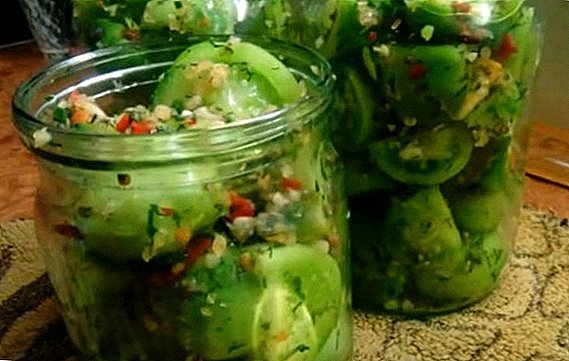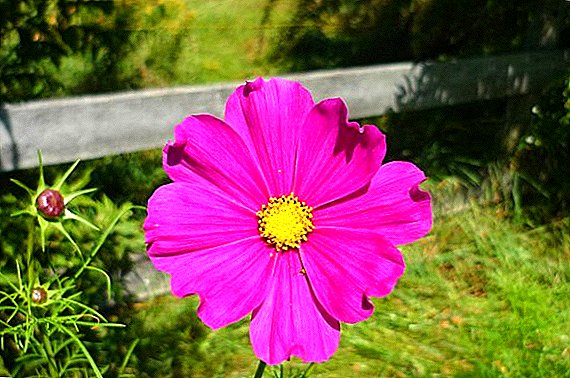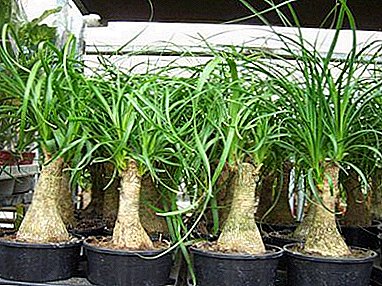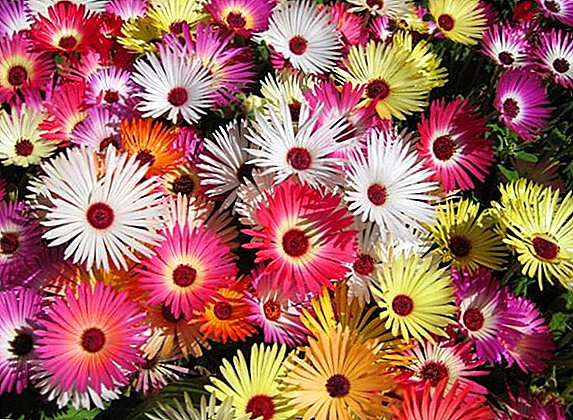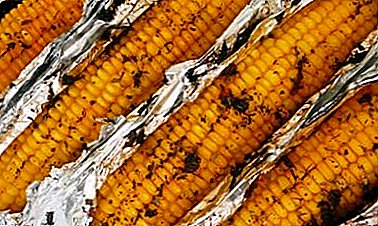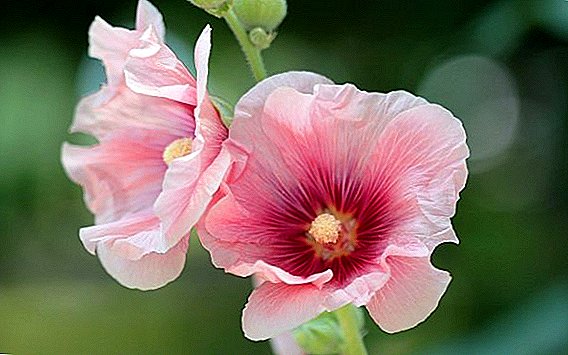 Homeland of this beautiful ornamental plants consider North America and Africa. But in our latitudes, it has been growing since time immemorial. Our ancestors used mallow not only to decorate the area around the house, but also for medicinal purposes. We will talk about them further.
Homeland of this beautiful ornamental plants consider North America and Africa. But in our latitudes, it has been growing since time immemorial. Our ancestors used mallow not only to decorate the area around the house, but also for medicinal purposes. We will talk about them further.
The healing composition of mallow
Flower Mallow - a medicinal plant, the use of which lies in its composition.
It found:
- vitamins PP and A,
- mineral salts;
- starch;
- tannins;
- phytosterol;
- trace elements of iron, zinc, cadmium;
- essential oil;
- bitterness;
- anthocyanin (dye).
But the most valuable component are plant mucus. Thanks to them, the plant is used as a means of combating cough. Infusion of mallow has an expectorant, enveloping and astringent effect.
Useful properties of stock-rose, than useful mallow for the human body
 Most often, traditional medicine uses mallow flowers, but other parts of the plant have been used. It is used as a remedy for bronchitis and sore throats, for laryngitis, catarrh of the throat and other respiratory diseases. Also perfectly treats inflammation of the gastrointestinal tract, urinary tract. The principle of action is based on the fact that the mucus of the plant envelops the nerve endings in the organs of these systems and protects them from the effects of irritating substances. Accordingly, pain, swelling and inflammation in general are reduced.
Most often, traditional medicine uses mallow flowers, but other parts of the plant have been used. It is used as a remedy for bronchitis and sore throats, for laryngitis, catarrh of the throat and other respiratory diseases. Also perfectly treats inflammation of the gastrointestinal tract, urinary tract. The principle of action is based on the fact that the mucus of the plant envelops the nerve endings in the organs of these systems and protects them from the effects of irritating substances. Accordingly, pain, swelling and inflammation in general are reduced.
Did you know? The closest relative of mallow is Altea medicinal. They have similar medicinal properties, only Althaea gives a more tangible effect. Also related to mallow are laureate, hibiscus and chinabella.
Traditional medicine also appreciated mallow, its beneficial properties and found use for them. At one time, the drug Flores Malvae arboreae nigrae was produced, but today it is used only in the manufacture of porridges and boluses.
Useful properties of mallow seeds
In addition to flowers, mallow seeds are used for treatment, 18% of which are fatty oils. In ancient Egypt, with their help, cleared the respiratory tract from harmful organisms. And today in the Arab countries they are used as a seasoning, an additive to teas and coffee. So, to make tea from mallow, it is enough to pour the seeds of your favorite kind of tea and add some honey for sweetness. For therapeutic purposes, the seeds are used for cystitis, skin diseases, poisoning (as an emetic). It is sometimes recommended for heart failure, sperm incontinence, dropsy, edema.
The useful leaves of mallow
 To relieve inflammation, cough and bronchitis use mallow leaves. From them prepare broths and infusions, add to teas. They are credited with diaphoretic and anti-spastic properties. It is believed that due to their enveloping properties, they can treat colitis, gastritis, dysentery. Mallow in combination with other medicinal herbs is used for the preparation of decoctions that have anti-inflammatory and softening effect. The leaves are also used to relieve erysipelas on the skin.
To relieve inflammation, cough and bronchitis use mallow leaves. From them prepare broths and infusions, add to teas. They are credited with diaphoretic and anti-spastic properties. It is believed that due to their enveloping properties, they can treat colitis, gastritis, dysentery. Mallow in combination with other medicinal herbs is used for the preparation of decoctions that have anti-inflammatory and softening effect. The leaves are also used to relieve erysipelas on the skin.
How to use mallow root
The plant has a powerful root, which also found application in alternative medicine. Mallow root contains the greatest amount of mucus, which has rewarded the plant with beneficial properties. From it is prepared a decoction, which can be applied inside or used as an external agent. Tincture of the root is used for compresses and treatment of various kinds of inflammation. Since ancient times, the treatment used extract of flowers and leaves of mallow, which relieves inflammation on the skin, swelling, promotes its regeneration, accelerates collagen synthesis and metabolism in the cells. The extract has a positive effect on the maturation of skin cells. Therefore, the tool is used in children's and adult cosmetics and hygiene products.  Mallow has been used in traditional medicine in China, where its root is used to treat bronchitis, colds, pneumonia, and various diseases of the gastrointestinal tract. In Tibet, its root is used for the preparation of diuretics. And the ancient healers chopped the root used to facilitate the generic processes.
Mallow has been used in traditional medicine in China, where its root is used to treat bronchitis, colds, pneumonia, and various diseases of the gastrointestinal tract. In Tibet, its root is used for the preparation of diuretics. And the ancient healers chopped the root used to facilitate the generic processes.
The use of mallow in traditional medicine: recipes
Alternative medicine uses mostly decoctions and infusions of various parts or the entire plant as a whole. They are taken internally or externally, depending on the type of disease. Here are some typical recipes using mallow. The properties of the mallow forest are not limited to anti-inflammatory action. It is known that the flower contributes to the production of melanin, so it is rinsed with his broths on the face and body to give the skin a honey tint. Extracts and extracts from stem-roses have a softening effect, so they are used in the manufacture of various cosmetic products: tonics, creams, gels.  With gastritis and inflammation of the stomach recommend infusion of the plant. Prepare it as follows. A tablespoon of chopped herbs is poured with a glass of boiling water and insulated in heat for two hours. Strain, drink it in small sips of warm. Take three to four times a day. Infusion should be stored in the refrigerator for no more than a day. For colds, sore throats and inflammations in the mouth, a decoction is prepared from stem-rose seeds. Pour a teaspoon of seeds into an enamel container and pour them with a glass of cold water. Put on a small fire, bring to a boil and incubate on fire for five minutes. When the decoction has cooled, filter it through two layers of gauze, and then use it for rinsing three to four times a day.
With gastritis and inflammation of the stomach recommend infusion of the plant. Prepare it as follows. A tablespoon of chopped herbs is poured with a glass of boiling water and insulated in heat for two hours. Strain, drink it in small sips of warm. Take three to four times a day. Infusion should be stored in the refrigerator for no more than a day. For colds, sore throats and inflammations in the mouth, a decoction is prepared from stem-rose seeds. Pour a teaspoon of seeds into an enamel container and pour them with a glass of cold water. Put on a small fire, bring to a boil and incubate on fire for five minutes. When the decoction has cooled, filter it through two layers of gauze, and then use it for rinsing three to four times a day.
To get rid of acne on the face will help a decoction of 1 gram of crushed mallow root, a tablespoon of linden flowers, the same amount of honey and a glass of water. After boiling for 10 minutes, the broth is cooled and used every day as a mask. Enemas from the collection of herbs with the participation of mallow flowers have shown their effectiveness in helminth infections. For the preparation of means take the head of garlic, a teaspoon of wormwood and mallow in 200 ml of water. From cooked broth put a warm enema at night. For children, take half cooked broth.  Pancreatitis is treated with the sap of the flowers of the plant. It is necessary to squeeze a teaspoon of juice and stir it in a glass of boiled water. Water should be with the addition of a teaspoon of honey. The resulting mixture is swallowed a tablespoon three times a day before meals. Malva is effectively used for weight loss. 10 g of flowers and foliage of the mallow are crushed, add the same amount of borage flowers and pour a glass of water. The mixture is boiled for 20 minutes, cooled and filtered. This broth is drunk for a month. Some sources recommend for this purpose to drink a decoction of mallow root.
Pancreatitis is treated with the sap of the flowers of the plant. It is necessary to squeeze a teaspoon of juice and stir it in a glass of boiled water. Water should be with the addition of a teaspoon of honey. The resulting mixture is swallowed a tablespoon three times a day before meals. Malva is effectively used for weight loss. 10 g of flowers and foliage of the mallow are crushed, add the same amount of borage flowers and pour a glass of water. The mixture is boiled for 20 minutes, cooled and filtered. This broth is drunk for a month. Some sources recommend for this purpose to drink a decoction of mallow root.
Important! Flowers are of particular value. plants, in which the highest concentration of carotene, vitamin C and sugars. But you need to collect them directly from the plant. Mallow has the ability to drop flowers at some point, although they look fresh, with no signs of wilting.
Not so long ago another property of mallow was discovered - stimulation of the immune system. It is believed that this is due to the polysaccharides contained in it. Mallow root helps with loss of strength and anemia. 4 tablespoons of crushed roots insist on a liter of white wine for two weeks in a dark cool place. The mixture must be shaken periodically. At the end of the term it is filtered and stored in the refrigerator. It is necessary to take 50 ml 3-4 times a day.  The properties of mallow flowers have a calming effect. To achieve it, you need to prepare an infusion of them and take it regularly. It is necessary to use fresh or dried inflorescences. Two teaspoons of raw materials must be crushed, pour a glass of boiling water and insist for at least three hours. Then strain and drink a tablespoon four times a day, and take two tablespoons before bedtime. Hop cones can also be added to mallow flowers.
The properties of mallow flowers have a calming effect. To achieve it, you need to prepare an infusion of them and take it regularly. It is necessary to use fresh or dried inflorescences. Two teaspoons of raw materials must be crushed, pour a glass of boiling water and insist for at least three hours. Then strain and drink a tablespoon four times a day, and take two tablespoons before bedtime. Hop cones can also be added to mallow flowers.
The use of mallow in cooking
The main use of plants in cooking - food paint, which is extracted from the flowers of the stem-rose. Sometimes they decorate desserts. In Caucasian cuisine, young leaves of the plant that have a sweetish taste are used in salads and stews. In the Arabic cuisine on the basis of mallow prepare soups and other dishes. The seeds of the plant are added to various drinks or as a seasoning.
Did you know? Young shoots and fruits of mallow and its related plants can even be eaten raw. Many find their taste very pleasant.
Mallow (stock-rose): preparation and storage of therapeutic raw materials
 Mallow is a valuable herb, in which the flowers, leaves, roots and other parts have medicinal properties. And you can collect them throughout the flowering, and it blooms from June until the beginning of the cold weather. The collection is carried out early in the morning, removing the leaves, flowers, and buds. In the same period, dig up the roots of the plant. Raw materials are dried in the shade in the fresh air, scattering a thin layer under a canopy. If the drying is correct, the raw material retains its color, and the roots have a pleasant aroma.
Mallow is a valuable herb, in which the flowers, leaves, roots and other parts have medicinal properties. And you can collect them throughout the flowering, and it blooms from June until the beginning of the cold weather. The collection is carried out early in the morning, removing the leaves, flowers, and buds. In the same period, dig up the roots of the plant. Raw materials are dried in the shade in the fresh air, scattering a thin layer under a canopy. If the drying is correct, the raw material retains its color, and the roots have a pleasant aroma.
Important! Blanks should not be in direct sunlight! Otherwise, they will lose color and some useful properties.
Store the harvested raw materials in bags of natural fabric. They should be suspended in a dark, well-ventilated area. It is strictly forbidden to store the workpiece in the sun or at heat sources: central heating batteries, heating appliances and other things.
Contraindications
Mallow plant is surprising in nature: it has a huge number of useful properties and has no contraindications. The only thing to fear is the individual intolerance of its components. Therefore, before using the plant in the treatment, discuss this issue with your doctor.  Mallow - very popular plant in our strip. Many use it as a decor on personal plots. But the plant has many useful properties that were known to our ancestors. Its main use is an anti-inflammatory and expectorant. In this case, mallow has no contraindications. It is easy to grow it, and collecting raw materials can be all summer until mid-autumn.
Mallow - very popular plant in our strip. Many use it as a decor on personal plots. But the plant has many useful properties that were known to our ancestors. Its main use is an anti-inflammatory and expectorant. In this case, mallow has no contraindications. It is easy to grow it, and collecting raw materials can be all summer until mid-autumn.


